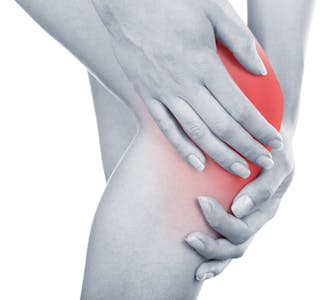Quadriceps Muscle Strains

This injury is commonly the result of quick sprints or quick stops while running. With a muscle strain, there is localized tenderness or a “bulge” in the tender area of the thigh. The pain is aggravated by lifting the thigh (a straight leg raise), ascending/descending stairs, or getting up from a seated position.
Anterior Cruciate Ligament (ACL) Tear
The cruciate (or crossing) ligament stabilizes the knee. The anterior cruciate (ACL) may completely break (rupture) when the knee is bent beyond its normal range of motion or with excessive twisting. Signs and symptoms include a ‘pop’ sensation with significant swelling and pain. There is a sense of instability or the knee giving away. Initial treatment includes rest, ice, elevation, and compression. Physical therapy consisting of progressive strengthening and functional exercise may facilitate recovery. If knee instability persists, surgery is indicated. The middle third of the patellar tendon, hamstrings, or cadaver ligament may be used to reconstruct the lost ligament.
ACL tears are common in teenage female athletes. Some of the best clinical/sports medicine research to date, suggests that a preventive training program can significantly reduce the risk of ACL injuries in female adolescent athletes.
Knee Osteoarthritis
Osteoarthritis of the knee occurs when the cartilage coverings on the end of the femur and the top of the tibia wear out. The tibia has two special cartilage pads called menisci (one is called a meniscus). This cartilage becomes flattened, bone spurs form, the joint becomes inflamed, range of motion is lost, there is ensuing weakness, pain and difficulty with walking, climbing stairs, and getting in/out of chairs. Physical therapy can help with recovery of range of motion, strength, walking skills, and pain management. Aquatic therapy (often involving a customized exercise program) can be helpful.
After total knee replacement (also called a total knee arthroplasty), physical therapy helps with recovery of range of motion, pain management, strength, balance and walking skills, and endurance. Commonly, patients say, “Why did I have this surgery? I am worse off now.” You must be patient. Give yourself at least 3 months to recover.
About Total Knee Replacement
Joint replacement is becoming more common, and hips and knees are the most commonly replaced joints. In 2006, 542,000 total knee replacements and 231,000 total hip replacements were performed.
The new joint, called a prosthesis, can be made of plastic, metal, or both. It may be cemented into place or uncemented. An uncemented prosthesis is designed so that bones will grow into it.
First made available in the late 1950s, early total knee replacements did a poor job of mimicking the natural motion of the knee. For that reason, these procedures resulted in high failure and complication rates. Advances in total knee replacement technology in the past 10 to 15 years have enhanced the design and fit of knee implants.
Total knee replacement is often the answer for people when x-rays and other tests show joint damage; when moderate-to-severe, persistent pain does not improve adequately with nonsurgical treatment; and when the limited range of motion in their knee joint diminishes their quality of life.
In the past, patients between 60 and 75 years of age were considered to be the best candidates for total knee replacement. Over the past two decades, however, that age range has broadened to include more patients older than 75, who are likely to have other health issues, and patients younger than 60, who are generally more physically active and whose implants will probably be exposed to greater mechanical stress.
About 90 percent of patients appear to experience rapid and substantial reduction in pain, feel better in general, and enjoy improved joint function. Although most total knee replacement surgeries are successful, failure does occur and revision is sometimes necessary. Risk factors include being younger than 55 years old, being male, being obese, and having osteoarthritis, infection, or other illnesses.
Physical Therapy Pre and Post Surgery
There are a number of reasons why you should see a physical therapist before you consider a knee replacement and after surgery as well.
- Physical therapy is proven to be a successful treatment for arthritis; therefore, a physical therapist directed program could help you delay or avoid knee replacement.
- Seeing a physical therapist before surgery and going through a “prehab” program (a set of rehabilitative exercises before surgery) is proven to increase strength and speed the post-surgical recovery process.
- Post-surgical physical therapy for knee replacement patients is a must. While most knee replacement patients experience a significant reduction in pain, almost all knee replacement patients suffer from considerable muscle weakness, loss of range of motion, and limited function. Seeing a physical therapist after surgery can greatly improve your strength, mobility and function.
Give us a call to learn more about how we can help you.
